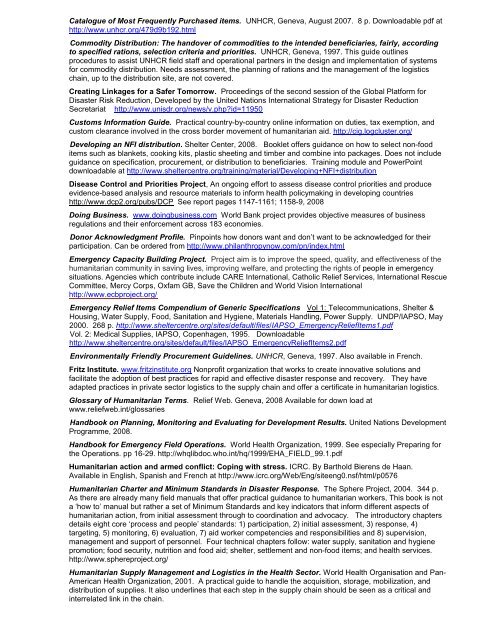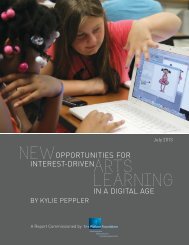Checklist for Effective Disaster Response: Insights for Wise ...
Checklist for Effective Disaster Response: Insights for Wise ...
Checklist for Effective Disaster Response: Insights for Wise ...
Create successful ePaper yourself
Turn your PDF publications into a flip-book with our unique Google optimized e-Paper software.
Catalogue of Most Frequently Purchased items. UNHCR, Geneva, August 2007. 8 p. Downloadable pdf athttp://www.unhcr.org/479d9b192.htmlCommodity Distribution: The handover of commodities to the intended beneficiaries, fairly, accordingto specified rations, selection criteria and priorities. UNHCR, Geneva, 1997. This guide outlinesprocedures to assist UNHCR field staff and operational partners in the design and implementation of systems<strong>for</strong> commodity distribution. Needs assessment, the planning of rations and the management of the logisticschain, up to the distribution site, are not covered.Creating Linkages <strong>for</strong> a Safer Tomorrow. Proceedings of the second session of the Global Plat<strong>for</strong>m <strong>for</strong><strong>Disaster</strong> Risk Reduction, Developed by the United Nations International Strategy <strong>for</strong> <strong>Disaster</strong> ReductionSecretariat http://www.unisdr.org/news/v.php?id=11950Customs In<strong>for</strong>mation Guide. Practical country-by-country online in<strong>for</strong>mation on duties, tax exemption, andcustom clearance involved in the cross border movement of humanitarian aid. http://cig.logcluster.org/Developing an NFI distribution. Shelter Center, 2008. Booklet offers guidance on how to select non-fooditems such as blankets, cooking kits, plastic sheeting and timber and combine into packages. Does not includeguidance on specification, procurement, or distribution to beneficiaries. Training module and PowerPointdownloadable at http://www.sheltercentre.org/training/material/Developing+NFI+distributionDisease Control and Priorities Project, An ongoing ef<strong>for</strong>t to assess disease control priorities and produceevidence-based analysis and resource materials to in<strong>for</strong>m health policymaking in developing countrieshttp://www.dcp2.org/pubs/DCP See report pages 1147-1161; 1158-9, 2008Doing Business. www.doingbusiness.com World Bank project provides objective measures of businessregulations and their en<strong>for</strong>cement across 183 economies.Donor Acknowledgment Profile. Pinpoints how donors want and don’t want to be acknowledged <strong>for</strong> theirparticipation. Can be ordered from http://www.philanthropynow.com/pn/index.htmlEmergency Capacity Building Project. Project aim is to improve the speed, quality, and effectiveness of thehumanitarian community in saving lives, improving welfare, and protecting the rights of people in emergencysituations. Agencies which contribute include CARE International, Catholic Relief Services, International RescueCommittee, Mercy Corps, Oxfam GB, Save the Children and World Vision Internationalhttp://www.ecbproject.org/Emergency Relief Items Compendium of Generic Specifications Vol 1: Telecommunications, Shelter &Housing, Water Supply, Food, Sanitation and Hygiene, Materials Handling, Power Supply. UNDP/IAPSO, May2000. 268 p. http://www.sheltercentre.org/sites/default/files/IAPSO_EmergencyReliefItems1.pdfVol. 2: Medical Supplies, IAPSO, Copenhagen, 1995. Downloadablehttp://www.sheltercentre.org/sites/default/files/IAPSO_EmergencyReliefItems2.pdfEnvironmentally Friendly Procurement Guidelines. UNHCR, Geneva, 1997. Also available in French.Fritz Institute. www.fritzinstitute.org Nonprofit organization that works to create innovative solutions andfacilitate the adoption of best practices <strong>for</strong> rapid and effective disaster response and recovery. They haveadapted practices in private sector logistics to the supply chain and offer a certificate in humanitarian logistics.Glossary of Humanitarian Terms. Relief Web. Geneva, 2008 Available <strong>for</strong> down load atwww.reliefweb.int/glossariesHandbook on Planning, Monitoring and Evaluating <strong>for</strong> Development Results. United Nations DevelopmentProgramme, 2008.Handbook <strong>for</strong> Emergency Field Operations. World Health Organization, 1999. See especially Preparing <strong>for</strong>the Operations. pp 16-29. http://whqlibdoc.who.int/hq/1999/EHA_FIELD_99.1.pdfHumanitarian action and armed conflict: Coping with stress. ICRC. By Barthold Bierens de Haan.Available in English, Spanish and French at http://www.icrc.org/Web/Eng/siteeng0.nsf/html/p0576Humanitarian Charter and Minimum Standards in <strong>Disaster</strong> <strong>Response</strong>. The Sphere Project, 2004. 344 p.As there are already many field manuals that offer practical guidance to humanitarian workers, This book is nota ‘how to’ manual but rather a set of Minimum Standards and key indicators that in<strong>for</strong>m different aspects ofhumanitarian action, from initial assessment through to coordination and advocacy. The introductory chaptersdetails eight core ‘process and people’ standards: 1) participation, 2) initial assessment, 3) response, 4)targeting, 5) monitoring, 6) evaluation, 7) aid worker competencies and responsibilities and 8) supervision,management and support of personnel. Four technical chapters follow: water supply, sanitation and hygienepromotion; food security, nutrition and food aid; shelter, settlement and non-food items; and health services.http://www.sphereproject.org/Humanitarian Supply Management and Logistics in the Health Sector. World Health Organisation and Pan-American Health Organization, 2001. A practical guide to handle the acquisition, storage, mobilization, anddistribution of supplies. It also underlines that each step in the supply chain should be seen as a critical andinterrelated link in the chain.








